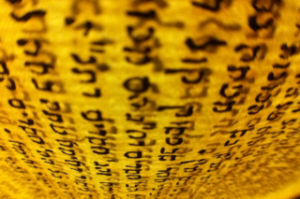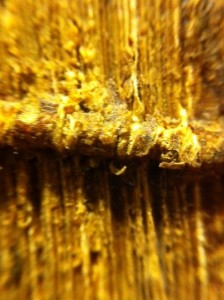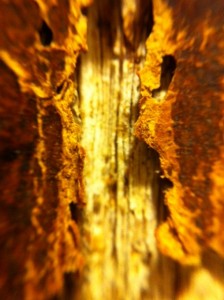The Syntax of Being (Part 2)
By Asher Crispe: June 12, 2012: Category Inspirations, Quilt of Translations
Lurianic Models and Beyond
Ontotextual Ubiquity and Omnitextual Ontology (continued)
 What we are able to secure with our observations about diacritics—the marks that are unmarked in the Torah scroll—is the fluidity of a text whose perfection lies in its mandatory incompleteness. Diacritics ratify the theory of textual incompleteness. They prevent the text from becoming an idol. What is written must appeal to the unwritten. Reading must be the marriage of the written and oral.
What we are able to secure with our observations about diacritics—the marks that are unmarked in the Torah scroll—is the fluidity of a text whose perfection lies in its mandatory incompleteness. Diacritics ratify the theory of textual incompleteness. They prevent the text from becoming an idol. What is written must appeal to the unwritten. Reading must be the marriage of the written and oral.
This partnership that generates meaning for the half-written text, draws heavily upon the oral tradition. As Marc-Alain Ouaknin observes:
The aims of the Torah she-be-al Peh [the Oral Torah] were originally set out in five categories:
- phonetics
- spelling
- syntax
- method
- semantics (12)
Thus the full name that translates as “Being” [Havayah] must gather the absence and presence of audio-visual experience [with the yud-hei corresponding to the Cantillation and Vowels and the vav-hei relating to the Crowns and Letters] in the reading of a work that amounts to the work of reading. We labor to read a text which is there but not all there in the full spectrum of its textuality. Our reading, a mending of written and oral, of inside and outside, registers as a kind of settling of accounts, shifting and shaping the stories told and balancing the exchange of values in the interpretive scheme.
Our text, like many of the symbols of the Lurianic Kabbalah, relies heavily on the isomorphism of the four letter Divine name and the four-fold layers of textuality. In commenting on this sort of functionality in mathematics, Douglas Hofstadter points out that: “…symbols of a formal system, though initially without meaning, cannot avoid taking on ‘meaning’ of sorts, at least if an isomorphism is found.” (13)
The Lurianic packaging of conceptual series, accompanied by elaborate mathematical models to translate and orchestrate those series, would seem to qualify as a ‘formal system’ where the relationships between its symbols are emphasized over there individual definitions as terms with meaning in and of themselves. There is a heavy reliance on isomorphism—particularly of when it comes to numeric pairing of conceptually discreet sets such as: the four letters in the Divine name, four expansions of those letters as modes of Being, four textual layers, four worlds, etc..
Thus, what works for Hofstadter works for Luria: “isomorphisms induce meaning.” (14) Moreover, our ideal non-idolatress text with is coherence of present and absent formalized markings invites comparison to the “‘essential incompleteness’ of formalized mathematics.” (15) This ‘essential incompleteness’ allows for an evolutionary process or סדר השתלשלות [seder histalshelut] that unleashes the potential meanings from the manifold properties of the text.
Revisiting Wolfson once more, we ascertain that: “The emergence of divine textuality is portrayed in kabbalistic literature as the evolution of consciousness and the articulation of speech, that is, a progression from silence to language that is expressed graphically and phonically.” (16) In our case, dealing with the meta-textual considerations of the text of all texts, of onto-textuality, we encounter an abundance of rarified phenomena the likes of which are partially captured in a description by Michael Fishbane:
The opening of Scripture from within radically transforms the grammaticality of the text: the ordinary connections between the letters of a word and between the words of a sentence are broken. These components now become extra-ordinary. Indeed, each letter has (virtual) anagrammatical significance; each word may encode numerous plays and possibilities; and each phrase has any number of potential correlations within Scripture. Midrash determines the sense of each component through extending the context of the component to the entirety of Scripture (thus the original setting or sequence is often immaterial)….The emergent enchainment (harizah) of possibilities thus dramatizes what is always the presupposition of Midrashic exegesis: that all Scripture is one interconnected whole. (17)
As an integral whole, Scripture in the kabbalists eyes becomes the nexus of relations that assists in the envisioning of an invisible God, as Fishbane continues relating: “…that proper penetration of the veils of Scripture will lead to an ecstatic vision of the cosmic form of God, who is actually formed out of Scriptural language—a kind of hieroglyphic hologram!” (18)
As for his choice of words, Fishbane’s notion of a ‘hieroglyphic hologram’ captures the Lurianic interinclusion of four levels within four. As a rule, the complexity of the system builds off of this interinclusion of the total number of elements in a particular set within each and every member of that set—hence the holographic effect. On a hermeneutical level, this vast interrelatedness offers many unconventional possibilities of decipherment.
 Added to the chorus of four-fold models and scales that we have been dealing with already, chimes in the exegetical methods known a Pardes consisting of the analysis of the plain meaning (Peshat), allusions (Remez), homiletical (Darash) and esoteric dimensions (Sod) of the text. Fishbane provides some summary observations about the domains of each of these respective modes of inquiry.
Added to the chorus of four-fold models and scales that we have been dealing with already, chimes in the exegetical methods known a Pardes consisting of the analysis of the plain meaning (Peshat), allusions (Remez), homiletical (Darash) and esoteric dimensions (Sod) of the text. Fishbane provides some summary observations about the domains of each of these respective modes of inquiry.
When cast in the Peshat or plain meaning of the text (equivalent to the letters alone in our tanta [טנת”א] model) he highlights this level: “as a received datum, this ‘thisness’ is what Santayana called ‘concretion in existence.’ [Moreover,] the Peshat thus focuses on the givenness and autonomy of the text, on its independence from the words of interpretation. The words of the text are all we have.” (19)
Here I would modify this description slightly. The “autonomy” of the text is never fully given. There is a kind of restricted economy of the plain meaning of the text that stems from the four levels tanta [טנת”א] existing in Lurianic fashion at every level thereby granting the Peshat (plain meaning) its readability. The apparent solidity of this level bears further examination. Sectioned off from the other levels of interpretation, the plain meaning of the text never achieves true independence. The rules for reading are already suggestive of all levels of text and interpretation being co-substantive and co-extensive.
The separation between one level and another would be the primary development of our application of abstract formalisms in the dissecting of the text into component parts. Nonetheless, we can continue to string together Fishbane’s reading of the rest of the Pardes (exegetical methods) according to their function: “Remez is the allegorical sphere of text interpretation….Accordingly, we may say that the Remez involves the determination of significance by means of factors independent of, and external to, the textual surface (the Peshat).” (20)
Only here, does Fishbane imply a level of diacritical accompaniment and the division into an inside/outside of the text. Fused with Derrida, we would have to contend that in our Lurianic model, even the outside/inside distinction is already inside the text as evident from its incompleteness.
Moving on, the “Derash is the third level of PaRDeS, and includes the tropological and moral spheres of text interpretation. The tropological aspect has traditionally indicated metaphorical and figurative features of a text.” (21) At this level, more and more of the outside (outside the literal) is to be offered up to the interpretive movement. The extra-textual grabs the spotlight as we absorb every outside, every diacritic into the prism of our exegetical proceedings. As José Faur beautify anchors it:
In a derasha-text no parergon [outside the main subject/work or alternatively a frame as in the framing of the work (my insertion)] is tolerated. More precisely, even the parergon of the text or calligraphic ornamentations (tagim) may generate meaning: the ‘outside’ is thus the ‘inside.’ One of the peculiarities of R. ‘Aqiva and his school—the most influential movement in the rabbinic period—was the application of derasha to all the elements of the text, including syntactical particles and calligraphic ornamentations. (22)
Finally, wrapping up the Pardes model, once again Fishbane sheds light on the subject citing that the “…sod is more than the eternity of interpretation from the human side. It also points to the divine mystery of speech and meaning.” (23) The esoteric level therefore, contains the irreducibly transcendent dimension.
Much of the possibility of these variant approaches to reading the text stems from the introduction of more and more outside material. This is not merely a comparison of contexts or conventional language games. While these techniques apply as well, the most profound contribution to the elasticity of the text emerges from the artificial separation of diacritical strata from the literal composition, which effectively paralyzes our reading even a basic message. Then through different degrees of dynamic interaction, the diacritics (Crowns, Vowels and Cantillation) can be reintegrated to engender the polysemia of broadband transmission.
Anyone of the diacritical levels, when thrown into the interpretive mix, completes the text or rather directs it towards greater and greater degrees of completion. We might consider the idea of sexual reproduction as an appropriate model for this type of textuality. The inside (letters) outside (diacritics) or written/oral distinctions (not that they are identical) yield a semblance of male-female conjunction. (24) Readings are born out of this union.
Mutation and adaptation as the engines of evolution are operative to the extent that they are in rabbinic literature thanks to this elegant design. Asexual reproduction wherein all outside influences (male) are contained within the inside (female) would be tantamount to a ridge text that when read or copied would provide for only one highly restricted set of reproductive possibilities. The collapse of all meaning into an immanent form, without recourse to an outside, to a tradition of orality, to inter-textuality, to sexual acts of language construction, would produce the stasis of an idol text: the manual.
The pure self-referential quality of the manual amounts to carbon copy upon carbon copy in the cloning effect of asexual textural reproduction. Every act of reading would constitute another reproductive act. The sexuality of reading, the pregnancy and birth of meaning, can be seen as an extension or infinitization of the Torah.
 In the words of Moshe Idel writing on the “Infinities of Torah in Kabbalah”: “The Torah scroll, written without vowels, is therefore pregnant with a variety of vocalizations, all of them possible without any change in the canonical form of the sacred text.” (25)
In the words of Moshe Idel writing on the “Infinities of Torah in Kabbalah”: “The Torah scroll, written without vowels, is therefore pregnant with a variety of vocalizations, all of them possible without any change in the canonical form of the sacred text.” (25)
Presumably the “pregnant” possibilities are more than the range of vocalizations. The over-extended sign (a letter with a crown ornament) and the syntax and grammar of the Cantillation are also pregnant. With regard to the canonical form of the letters, they provide stability and continuity of textual identity even as the diacritical companions accomplish difference. Identity and difference, in their dialectical tension within a human subject, dwell in like fashion in the text. Moreover, our ability to recognize ourselves in the text, to feel at home textually, depends on our recognizing this struggle of the old-new, repeatable and unique, for:
Language is the house of Being. In its home man dwells. Those who think and those who create with words are the guardians of this home. Their guardianship accomplishes the manifestation of Being insofar as they bring the manifestation to language and maintain it in language through their speech. (26)
12 The Burnt Book, p.8.
13 Gödel, Escher, Bach: An Eternal Golden Braid. P.51.
14 Ibid. p.49.
15 Ibid. see p.P6 (Preface page 6).
16 From Sealed Book to Open Text, p.146.
17 The Exegetical Imagination, pp.12-13
18 The Garments of the Torah, pp.42-43.
19 Ibid. p.115.
20 Ibid. p.116.
21 Ibid. p.118.
22 Golden Doves with Silver Dots: Semiotics and Textuality in Rabbinic Tradition, p,xxviii.
23 The Garments of the Torah, p.120.
24 See Tikunei Zohar 153b “‘Every male child born must be thrown in the Nile’— this is the Written Torah; ‘every female child shall be allowed to live’—this is the Oral Torah” (“כל הבן הילוד היאורה תשליכוה, דא אורייתא דבכתב, וכל הבת תחיין דא אורייתא דבעל פה.”)
25 In Midrash and Literature, p.146.
26 Heidegger: “Letter on Humanism” in Basic Writings, p.217.
http://www.interinclusion.org/inspirations/the-syntax-of-being-part-3/













;)
;)
;)
;)
;)
;)
;)
;)
;)
;)
